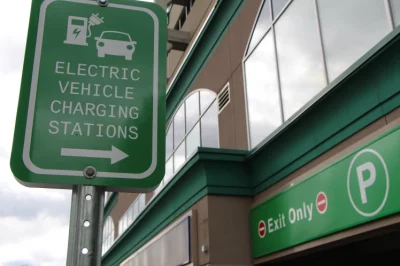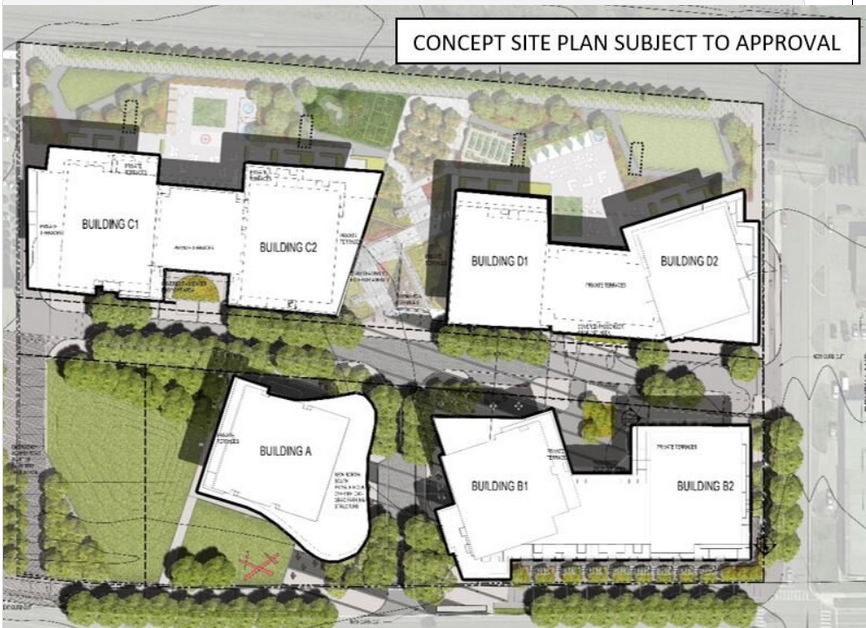 By Connor Fraser
By Connor Fraser
March 27th, 2022
BURLINGTON, ON
OPINION
Electric vehicle charging infrastructure is becoming a real problem – and it’s likely going to get a lot worse.

The city has installed a number of charging stations in its parking lots.
If you’ve driven past Mapleview Mall recently, chances are that you’d notice a flock of cars waiting to access the electric vehicle (EV) charging stations. Through my family and friends, I know several young and middle-aged individuals who recently purchased an EV, and every third day must line up and wait in limbo for 30+ minutes while their car charges. What a (mostly avoidable) real waste of time.
I have also spoken with many who live in condominiums or apartment buildings that are reluctant to purchase EV’s because their parking spaces are not yet equipped with the necessary infrastructure. In an existing condo or apartment, the barrier becomes enormous due to large renovation costs. If residents who are not currently in the market for an EV don’t want to contribute, the expense becomes too prohibitive to share amongst the few residents that do. Many of my friends are first-time car owners and – since they tend to live in apartments – found the lack of infrastructure especially constraining of their excitement to purchase an EV.

There are charging stations throughout many cities.
Electric Vehicles are a real part of our future. In 2021, the Federal Government announced an ambitious target to ensure that 100% of car and passenger truck sales are zero-emission by 2035. The question becomes: How can we adopt this technology in a way which maximizes convenience, and minimizes disruptions – such as wasting time lining up to use public charging stations? Electric vehicles are a distinct technology requiring different interactions than conventional autos. Electricity cannot be transferred as rapidly as gasoline, which makes charging painful for those short on time. Although EVs are increasingly evident on the streets, I don’t believe that anyone (government, community groups) is having a serious conversation about the infrastructure required to support their use, and how that infrastructure should be distributed.
My opinion is this: We should aggressively prioritize uptake of private charging infrastructure, and carefully plan public or semi-private infrastructure to “fill in the gaps” and accommodate those who cannot access private charging. Research shows that poorly planned public charging infrastructure goes underutilized, and is rarely profitable as an investment. Furthermore, consumer research consistently reveals a preference for the convenience of private charging opportunities wherever possible, given the amount of time it saves. Imagine replacing the semi-weekly routine of replenishing your vehicle (and how much time that wastes every week, month, year, decade,…), with a simple “plug and done” routine when you arrive home from work. This reality is possible for most people, but rapidly slipping away.

This development is at the settlement stage with the Ontario Land Tribunal – has the installation of charging stations been included in the settlement?
There is a major role for the provincial and municipal governments to play in this endeavour. At the provincial level, the building code should be immediately updated to require that all new residential constructions (i.e. single detached homes, apartments, and condominiums) have the capacity and “rough-in” connections to support Level-2 EV charging to 100% of parking spaces. This is a no-brainer. Every new apartment, condo and single detached home that is built without this equipment sets the stage for an expensive renovation, or community dispute somewhere down the line. Conversations with real-estate developers, combined with my own secondary research suggest that many new builds do not come with adequate EV infrastructure (if any) – and that the private sector cannot be relied upon to provide solutions. They will build to the minimum standard required, and shouldn’t be blamed for it: The standard needs to be higher.

When Bunton’s Wharf was built electric cars were not part of the way people drove. Who will pay to put charging stations in these buildings. The Condo Corporation is going to have to take on that task.
The province should go one step further and require that owners of existing apartment buildings and condominiums equip 100% of parking spaces with Level-2 charging capacity and energy management systems by 2035. Implementing this requirement might be aided with a standalone legislative tool. For condominiums, the government could offer to cover one quarter of renovation costs before 2025, one fifth before 2030 and none thereafter, with fines for non-compliance beginning in 2035. To demonstrate a commitment to equity, for apartments, co-ops, and community housing, the government could offer to cover half of renovations costs before 2025, one third before 2030 and one fifth before 2035.
Noncompliant landlords of these complexes (including municipalities, in the case of community housing) could be targeted with even more stringent fines after 2035. Without stronger direction, governance issues might delay apartment and condominium residents from benefitting from convenient charging infrastructure and prolong decisions to remain with gasoline vehicles.
Since municipalities have control over open-air parking spaces through zoning bylaws, their role should be to plan targeted public infrastructure that accommodates those without private options. This might include bylaws mandating all workplaces (existing and planned) have a small percentage of parking spaces equipped with Level-2 chargers for exclusive use by those without access to private parking.
Additional bylaws might require all shopping, grocery, and community centres have a small percentage of parking spaces equipped with Level-3 chargers. The percentage should be increased for those locations within a short radius (i.e. 2km) of highway exits to ease range anxiety of those making long distance trips. Promoting highway-proximate infrastructure in this manner would offer the added benefit of maximizing infrastructure utilization in periods of low travel, while offering minimal inconvenience to travelers.
Approaching charging infrastructure in this fashion has the upside of maximizing the convenience of private charging, accommodating travelers and those without private options, and minimizing the potential underutilization of widespread public charging infrastructure.

Ontario has charging stations along the full length of the 401 – at some point every major community in the province will have public parking stations. Better restaurants and hotels will include them.
By not actively coordinating charging infrastructure at the provincial-municipal level, purchasing an EV will bring increasing and unnecessary challenges to first-time home buyers and those living in apartments and condominiums. This includes a significant number of individuals in the young and old-age demographic. A “laissez-faire” approach also carries negative implications for meeting climate targets, and Ontario’s ability to sustain an innovative manufacturing sector.
Please consider submitting your opinion to the City of Burlington’s Electric Mobility Strategy survey by March 31, 2022: https://www.getinvolvedburlington.ca/electric-mobility-strategy
 Connor Fraser is a post graduate student at the University of Toronto enrolled in the dual Master of Global Affairs and Master of Business Administration program.
Connor Fraser is a post graduate student at the University of Toronto enrolled in the dual Master of Global Affairs and Master of Business Administration program.



















I really can’t tell you how badly I feel for those low income neighbours who have to wait for their free charge at Mapleview Mall. Perhaps they are in over their head in debt.
Fantastic article. EV charging infrastructure is something that is often overlooked when purchasing an EV so I’m glad that you are shining some light on it. Although it seems like EVs are the inevitable future of the automotive industry, it really only makes practical sense (from a political point of view) to invest in EV charging infrastructure to the extent that it will slightly exceed demand to ensure that there is sufficient charging for the present and to incentivize future growth over time. I feel that the survey you noted at the end is a great way to determine how much should be spent on EV charging infrastructure now, which is why I completed it (and thank you for sharing it).
Great article Connor. The timing is great with a provincial and municipal election this year.
This article oversimplifies what is required for a legacy non-profit condominium corporation to accommodate EV charging. Such articles often scapegoat or portray condominium corporations as being resistant to the needs of their owners. If anyone would care to take the time, they would find that condominium corporations are governed by the condominium Act 1998 and a democratically elected board of directors.
Condo corporations face 2 issues or hurdles with respect to accommodating what is expected to be an increased demand for electric vehicles. The first order of business is to determine whether the existing overall electrical capacity of the entity is sufficient to accommodate the number of electric vehicles that will be anticipated. This study is required to determine whether additional electrical infrastructure is required, the cost of which can be quite substantial. The cost to install the needed additional infrastructure would be borne by the owners of a condominium, the corporation is merely the vehicle by which that will take place.
The two common mechanisms for paying for EV charging infrastructure are, (a) by way of a “special assessment” or by (b) passing a borrowing bylaw that requires a 50% plus 1 majority agreement by the owners to secure a loan for the added additional infrastructure.
Condominium corporations do not have extra money and can only spend up to 10% of their annual budget to accommodate E.V. charging. Under any scenario, all funds to do this will be borne by condominium owners. Given that the overall infrastructure is now in place, the cost per station, which is borne by the owner can be upwards of $4000.
The writer goes on to suggest that “Noncompliant landlords of these complexes (including municipalities, in the case of community housing) could be targeted with even more stringent fines after 2035.non-profits should be fined”. I am not sure how “fines” will help and the money should go to paying for the needed charging stations.
Speaking as, a condominium owner in a Leeds building, a condo board of director and owner of a Hybrid vehicle, any funding by government is welcomed. If you are a condominium owner or council member you may inform yourself further by visiting the attached link.
https://www.condoauthorityontario.ca/resources/electric-vehicle-charging-station-regulations/